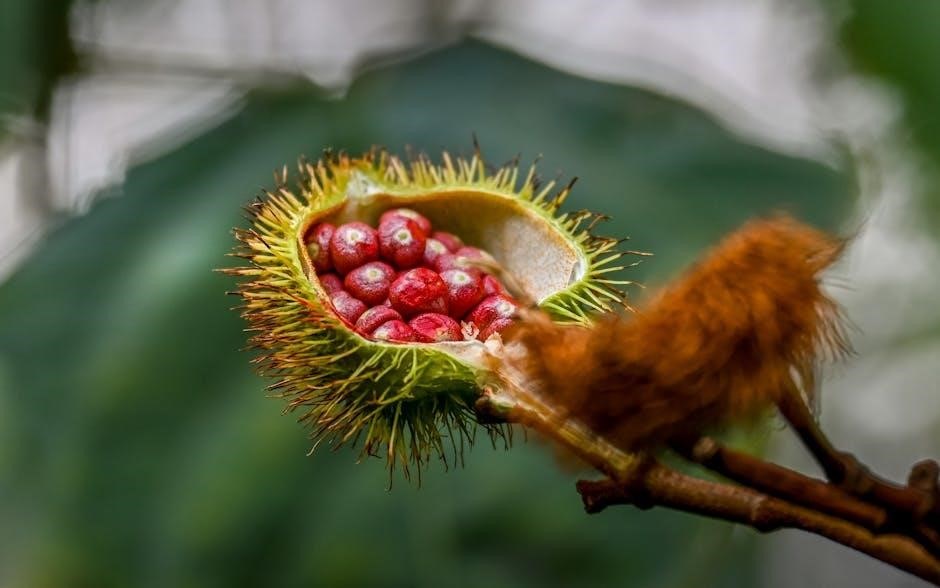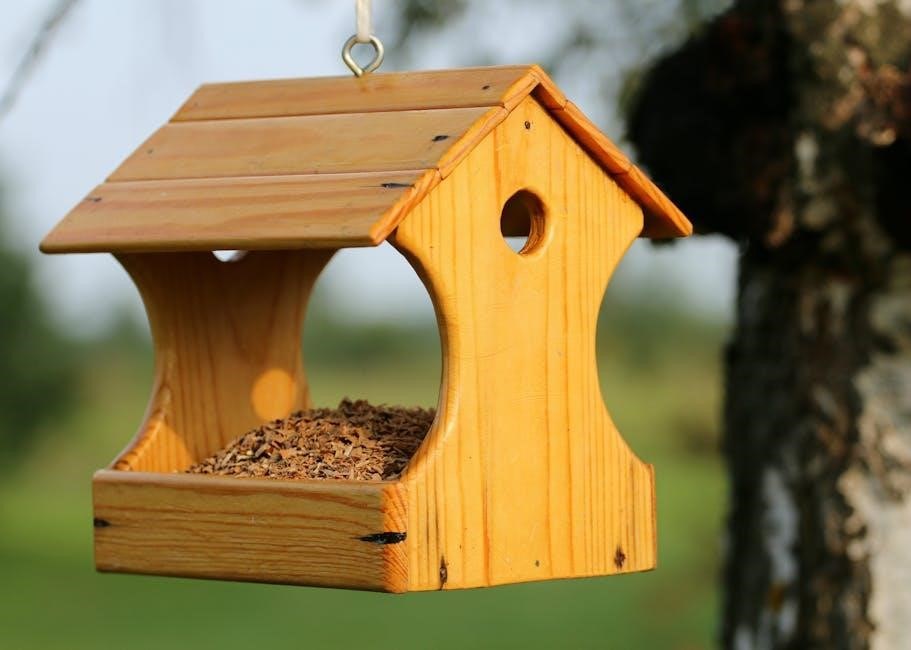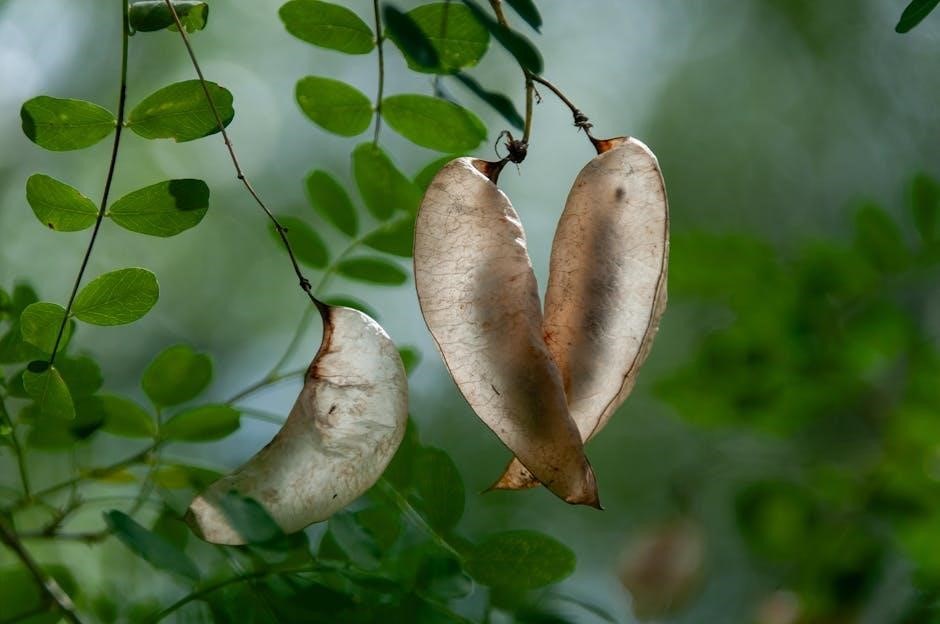
tree seed pod identification guide
Learning tree seed pod identification requires patience and observation of pod characteristics‚ utilizing online resources and guides to enhance skills and knowledge of tree species and their seed pods naturally.
Understanding the Importance of Seed Pods in Tree Identification
Seed pods play a crucial role in tree identification‚ offering a unique and often readily available method for determining species. Unlike leaves‚ which may be absent during certain seasons‚ or flowers‚ which are fleeting‚ seed pods often persist on the tree or litter the ground beneath it‚ providing year-round clues. By examining the characteristics of seed pods‚ including their size‚ shape‚ color‚ and texture‚ individuals can gain valuable insights into the identity of a tree. This knowledge can be particularly useful during periods of dormancy‚ when other identifying features may be absent. Furthermore‚ seed pods can be used in conjunction with other identification methods‚ such as observing bare branches and noting bud scars‚ bark texture‚ and branching patterns‚ to provide a more comprehensive understanding of tree species. This approach can be highly effective in enhancing tree identification skills.

Characteristics of Tree Seed Pods
Tree seed pods have distinct morphology‚ texture‚ color‚ and seed count‚ varying greatly between species naturally and easily.
Examining Pod Morphology‚ Texture‚ Color‚ and Seed Count
Examining pod morphology‚ texture‚ color‚ and seed count is crucial for accurate tree seed pod identification. The shape and size of the pod can vary greatly between species‚ with some being long and slender‚ while others are short and stout. The texture of the pod can also be an important identifying feature‚ with some being smooth‚ while others are hairy or prickly. The color of the pod can also be useful‚ with some being bright and vibrant‚ while others are dull and faded. Additionally‚ the number of seeds within the pod can be an important characteristic‚ with some species having only one or two seeds‚ while others have many. By carefully examining these features‚ it is possible to narrow down the possible species and make a more accurate identification.
Geographic Location and Tree Seed Pod Identification
Geographic location helps identify tree seed pods by considering regional species and climate factors naturally occurring.
Using Online Resources to Enhance Identification Skills
Utilizing online resources can significantly enhance tree seed pod identification skills‚ providing access to detailed databases and expert knowledge. Online forums and communities also offer a platform for discussion and sharing of information. Websites dedicated to tree identification often feature extensive galleries of images‚ allowing users to compare and contrast seed pods. Additionally‚ online resources can provide information on the geographic distribution of tree species‚ helping to narrow down identification possibilities. By leveraging these resources‚ individuals can improve their ability to accurately identify tree seed pods‚ even for species that are unfamiliar or rare. This can be especially helpful for those with limited experience or training in botany or tree identification‚ and can help to foster a greater appreciation for the diversity of tree species. Overall‚ online resources are a valuable tool for enhancing tree seed pod identification skills.

Dormant Tree Identification Techniques
Scrutinizing bare branches and noting bud scars‚ bark texture‚ and branching patterns helps identify dormant trees using specific observation methods and techniques naturally.
Scrutinizing Bare Branches and Noting Bud Scars‚ Bark Texture‚ and Branching Patterns
When identifying dormant trees‚ it is essential to examine the bare branches‚ looking for clues such as bud scars‚ bark texture‚ and branching patterns. Noting the size‚ shape‚ and scale of the tree’s silhouette can also be helpful. Additionally‚ observing whether the tree has opposite or alternate branching can aid in identification. By scrutinizing these characteristics‚ one can gain a better understanding of the tree’s structure and make a more informed identification. This method can be particularly useful during winter months when leaves and flowers are absent‚ providing a unique opportunity to observe the tree’s underlying features. Furthermore‚ this technique can be used in conjunction with other identification methods to increase accuracy and confidence in tree identification. Overall‚ scrutinizing bare branches is a valuable tool in the identification of dormant trees.

Seed Pod Identification Methods
Observing seed pod appearance‚ shape‚ and associated tree characteristics helps identify tree species accurately online.
Observing Seed Pod Appearance‚ Shape‚ and Associated Tree Characteristics
Observing seed pod appearance‚ shape‚ and associated tree characteristics is crucial for accurate identification.
Tree seed pods can be found in various shapes‚ sizes‚ and colors‚ making them a valuable tool for identification.
By examining the seed pod’s morphology‚ texture‚ and color‚ one can narrow down the possible tree species;
Additionally‚ considering the tree’s geographic location‚ growth habits‚ and associated features can help confirm the identification.
Online resources and field guides can provide detailed information and images to aid in the identification process.
By combining these factors‚ one can develop a comprehensive understanding of tree seed pod identification and improve their skills over time.
With patience and practice‚ observing seed pod appearance‚ shape‚ and associated tree characteristics can become a reliable method for identifying tree species.

Common Tree Seed Pods and Their Distinctive Features
Several tree species have distinctive seed pods that can be easily recognized.
For example‚ maple trees produce helicopter-like seeds‚ while acacia trees have long‚ thin pods.
Other trees‚ such as oak and beech‚ have capsule-like seed pods that contain multiple seeds.
These distinctive features can be used to identify the tree species‚ even when other characteristics like leaves or flowers are not present.
By familiarizing oneself with the common tree seed pods and their features‚ one can improve their ability to identify tree species.
Online resources and field guides can provide detailed information and images of common tree seed pods‚ making it easier to learn and identify them.
Understanding the distinctive features of common tree seed pods is an essential part of the tree seed pod identification guide.